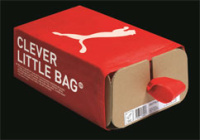A fine balance
Print has managed to shed its prime polluter mantle, thanks to innovations in paper, inks and processes. Design Week looks in detail at some approaches to making publications more sustainable
Royal College of Art degree show brochures
Designed by Happily Ever After, printed by Beacon Press
This year’s catalogues to accompany the Royal College of Art’s end-of-year graduate shows are a set of six designed by Happily Ever After.
Aiming to keep processes and materials as sustainable as possible, the consultancy says one of the main decisions was to print each catalogue individually, to target them more directly at people visiting each show and thus reducing waste. In addition, Happily Ever After always plans the optimum size of a publication around sheet size.
However, printing sustainable is always a balancing act, says Leah Harrison Bailey of Happily Ever After. For example, the project features an impactful fluorescent orange (fluorescents are always problematic from a sustainability point of view). After much discussion, the consultancy opted to avoid screenprinting for the ’mildly better’ litho to produce the colour.
The rest is printed in four-colour on Cocoon Silk 100, a 100 per cent recycled paper certified by the Forest Stewardship Council, for the text, with the covers on Cocoon Uncoated 100.
By choosing the Cocoon Offset range from Arjowiggins Graphic, the publications’ environmental impact was reduced significantly – by 1255kg of landfill, 31 300l of water and 292kg of greenhouse gases, for example.
Such carbon footprinting is relatively new, but increasingly popular, says Richard Owers of Beacon Press. Between 60 and 90 per cent of the carbon footprint of print projects comes from paper production, according to research from the Carbon Trust.
There are a lot more processes that help break down a project’s use of resources and its impact on the environment, says Harrison Bailey – really helpful for designers to understand what it all means
Notebooks
Designed by Tamasyn Gambell, printed by Calverts
Print production and design consultancy Calverts produced notebooks designed by Tamasyn Gambell from one piece of artwork. An A2-sized abstract pattern was printed in three spot colours on sheets of 320gsm Cairn Natural, 100 per cent recycled board left over from another job, avoiding the need to purchase and transport paper.
The imposition (the method in which individual pages are placed on a larger printed sheet) allowed up to eight unique cover designs to be achieved from a single artwork, minimising waste on the sheet by keeping to a trimmed size of A6, appropriate for an A2 sheet.
Designers can use imposition know-how to cut both the financial and the environmental costs of paper and print, says Calverts’ Arthur Stitt. The inner pages of the notebook were a selection of recycled papers which had been sitting on the shelf. These were left unprinted and randomly collated throughout the publication.
The plates used to print the cover were produced on a process-less computer-to-plate print system, dispensing with the need for chemical developer and water, and the inks used were vegetable oil-based and biodegradable.
The printing process itself was powered by renewable energy, and by using recycled paper (made from post-consumer waste which would otherwise have gone to landfill) 137kg of carbon was saved.
Thomas Matthews stationery
Designed in-house, printed by Calverts
Switching to a post-consumer recycled stock can save up to 70 per cent of the embodied energy of a piece of print, but when designing its own stationery, consultancy Thomas Matthews was keen to go further, so it rifled through its printer’s surplus stock and chose some suitable weights and finishes.
Vegetable-based inks may be low in volatile organic compounds (known as VOCs) and less polluting, but there are some serious questions around soy crop cultivation causing rainforest deforestation. Every time a designer asks for a particular spot colour the printer mixes up a tin. That’s a litre of ink when only a spoonful might be required. So instead of contributing to this global impact, Thomas Matthews spent an afternoon peering into leftover pots, checking them for low barium and copper along the way, to arrive at its new brand palette.
It then checked the supplier’s specification on metallic inks and explored the effect of using big floods of colour on the de-inking process. Experts confirmed that its proposed approach would not detract from the overall recyclability of the finished article.
’Once we had our paper and our inks, we could take these back to the studio and get designing,’ says consultancy co-founder Sophie Thomas. ’It may seem a backwards process starting with the restriction of leftover materials, then thinking about what items would make best use of space on the press sheet, but it made perfect sense to us.
-
Post a comment




